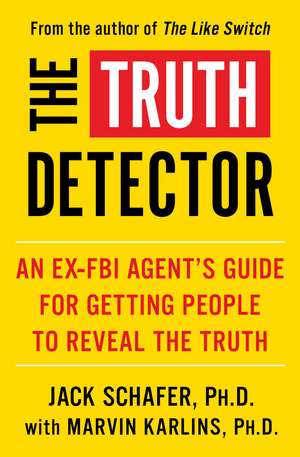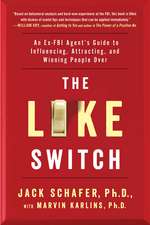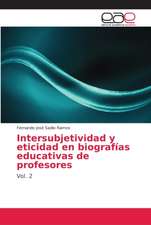The Truth Detector: An Ex-FBI Agent's Guide for Getting People to Reveal the Truth: The Like Switch Series, cartea 2
Autor Jack Schafer Cu Marvin Karlins Ph.D.en Limba Engleză Paperback – 12 noi 2020
Unlike many other books on lie detection and behavioral analysis, this revolutionary guide reveals the FBI-developed practice of elicitation, the field-tested technique for encouraging people to provide information they would otherwise keep secret. Now you can learn this astonishing method directly from the expert who created this technique and pioneered it for the FBI’s Behavioral Analysis Program.
Filled with easy-to-follow, accessible lessons reinforced by fascinating stories of how to put these skills into action using natural human behaviors, The Truth Detector shows you all of the tips and techniques you need to gain someone’s trust and get liars to reveal the truth.
Preț: 107.18 lei
Nou
20.51€ • 21.29$ • 17.10£
Carte disponibilă
Livrare economică 01-15 martie
Specificații
ISBN-10: 1982139072
Pagini: 288
Ilustrații: b-w images t-o
Dimensiuni: 140 x 213 x 23 mm
Greutate: 0.27 kg
Editura: ATRIA
Colecția Atria Books
Seria The Like Switch Series
Notă biografică
John R. “Jack” Schafer, PhD, is a psychologist, professor, intelligence consultant, and former FBI Special Agent. Dr. Schafer spent fifteen years conducting counter-intelligence and counterterrorism investigations, and seven years as a behavioral analyst for the FBI’s National Security Division’s Behavioral Analysis Program. He developed spy recruitment techniques, interviewed terrorists, and trained agents in the art of interrogation and persuasion. Dr. Schafer contributes online pieces for Psychology Today Magazine, has authored/coauthored six books, and has published numerous articles in professional and popular journals. He is a professor with the School of Law Enforcement and Criminal Justice at Western Illinois University.
Marvin Karlins received his PhD in psychology from Princeton University and is currently Professor of Management at the University of South Florida’s College of Business Administration. Dr. Karlins consults internationally on issues of interpersonal effectiveness and has also authored twenty-four books, including two national bestsellers, What Every Body Is Saying and It’s a Jungle in There. He resides in Riverview, Florida, with his wife, Edyth, and daughter, Amber.
Extras
CHAPTER 1 So Much for Shredders
All truths are easy to understand once they are discovered; the point is to discover them.
GALILEO GALILEI
The desire to know if someone is lying or telling the truth is as old as Adam and Eve in the Garden of Eden. And why not? How we act, how successful we are—even our survival—can be profoundly impacted by our ability to determine if information is true or false.
During my two decades as a special agent for the FBI, my job was to assess whether suspects, witnesses, and spies were withholding critical information and/or telling lies that could have far-reaching implications for the safety of specific individuals and, in some cases, the security of the entire country.
The question became: What was the best way to get truthful information from persons of interest? The traditional approach involved attempting to determine if the person was lying in the first place. This involved using mechanical devices (polygraph machines), physical observation (watching for nonverbal cues of deception), and various forms of interrogation designed to get the targeted individual to admit his or her dishonesty. But there was a problem with this approach: Even if it was successful in determining a person’s veracity, it came at a high cost. When people become aware that their honesty is being challenged, their “shields” go up, and whenever that happens, they are unlikely to voluntarily reveal the information they know. In fact, the opposite occurs: these individuals “clam up,” “lawyer up,” or “dummy up,” making any attempt to get information out of them a daunting if not impossible task. Thus, what happened when the traditional approach was used was that investigators could sometimes tell if certain information was true but lost the chance to discover other information that might have been even more valuable.
This made me and a group of my colleagues wonder if there was a better way to get people to reveal true information before they went into lying mode. I suspected that if individuals were not aware that I was trying to get critical information from them, they would be more likely to reveal it. Only if they became cognizant of my intentions would they become defensive, raise their shields, and begin withholding information and telling lies. Our strategy, then, was to get to the truth before the lies—in other words, extract the relevant information from a person of interest without them becoming aware of our intentions. If this could be achieved, the credibility of the information would almost always be solid and we could obtain it without the person shifting into information-withholding, lie-generating mode.
ELICITATION: LEARN THE TRUTH BEFORE THE LIE
Noting the flaws in the traditional interrogation techniques, I worked with my colleagues to come up with less confrontational techniques based on psychology and natural human behaviors as opposed to the more confrontational, old-school law enforcement interviewing techniques currently being used. The result was the noninvasive approach of elicitation—so named because it was designed to elicit the truth rather than detect lies. Elicitation techniques are relatively easy to master, because it is based on normal behaviors people rely on during conversations. Over my career I developed several elicitation techniques designed to extract information. These involve a conversational style whereby you use words in a way that encourages people to reveal the truth without them becoming aware of what you are attempting to accomplish. I will be teaching you these techniques in the coming chapters, but first I think it may help you understand elicitation more clearly if I present you with some historical perspective on how the technique was developed.
CREATING THE RIGHT ENVIRONMENT FOR ELICITATION
Possibly the most famous pioneer in using elicitation-style strategy was Hanns-Joachim Scharff (1907–1992). He worked for the German Luftwaffe at the intelligence and evaluation center in Oberursel, Germany, and became one of the most successful interrogators during World War II.
Scharff’s interrogation techniques deviated from those used by the feared German Gestapo. The Gestapo used emotional pain, physical deprivation, and authority in attempting to gain intelligence. Conversely, Scharff was noted for his friendly, conversational interrogation approach. He created a nonthreatening, noninvasive, comfortable environment wherein he rarely asked specific questions. In almost all cases Scharff would take his targets for a walk around the airfield with no guards nearby and engage them in what they thought was a casual conversation. His technique became known as the “change-of-scene” approach: giving his prisoner the impression that they were safe speaking to him. Since they then believed that this was not an interrogation, they felt more comfortable talking and telling the truth. Scharff wanted them to regard the interrogation room as the only place that an interrogation took place. He also created the illusion that he knew more information than he did. He would present information and then simply wait for the prisoner to either confirm or deny his statement.
After the war ended and the prisoners were repatriated, one of them commented, “You would impulsively pop off and correct him [Scharff]—probably this was one of his tactics.I Prisoners were more willing to confirm information they believed was already known for several reasons. First, they wanted to give the impression of minimal cooperation to avoid harsher interrogation techniques. Second, prisoners rationalized that no harm could be done if they merely corroborated information the enemy already knew as opposed to providing previously unknown information.
Scharff often told long, detailed stories, giving the prisoners the impression that he knew all, when in fact he knew very little. In the process of confirming information, prisoners often provided new details. To confuse the prisoners even further, Scharff’s conversational technique camouflaged the objectives of his interrogation. Scharff did not press prisoners for information but rather created a conversational environment wherein they were inclined to speak freely. When prisoners provided new information, Scharff would act as if he already knew what they were talking about and that the information was of little importance. As Scharff’s interrogations continued, it became clear over time that the information prisoners provided in response to his friendly approach was more likely to be truthful. They were not trained to resist Scharff’s congenial interrogation techniques and revealed critical intelligence information without realizing they were supplying details they would not have revealed under harsher interrogation techniques.
On one occasion Scharff was tasked with finding out why American fighter aircraft machine guns fired tracer bullets of a certain color. During a conversation with an American pilot held in a prisoner-of-war camp, Scharff casually brought up the subject. He made a presumptive statement (a form of elicitation; See Chapter 4), giving the pilot the illusion that he already knew the reason for the different-colored tracers. Unwittingly, the pilot revealed the true purpose of the bullets, which was simple: The different color was used to let pilots know when their ammunition was running low. The Germans were much relieved to obtain this information, because they had believed the tracers were being used for a far more sinister purpose.
Scharff was successful in extracting true information from prisoners of war because he understood the importance of empathy and rapport, two essential qualities to harness in order to effectively use elicitation. He imagined himself in the place of the prisoner, believing he would be more likely to communicate with his interrogator if he were treated with respect. Scharff also suspected prisoners would be more likely to reveal information if they liked their interrogator, so he tried to cultivate a rapport with those he interrogated.
Scharff’s insights were important, conceptual contributions to the enhanced elicitation approach you will be learning in this book. I will return to them in the next chapter. But first, let me give you another example of how the elicitation process works, using a gadget some automobile drivers are unaware is hidden within arm’s length of their steering wheel.
ASK A PERSON OR “TELL A MATIC”?
Pretend for a moment that you’re trying to get the very best auto insurance rate for your newly purchased car. You are an aggressive driver who has a lead foot and doesn’t mind taking a few risks on the road.
Your agent asks, “Are you a safe driver?”
What answer do you provide?
Or suppose you are in a hurry to get home one night and are driving recklessly, speeding to reach your destination. A few blocks short of your house, you run a red light and collide with another vehicle. There are no witnesses to the accident except you and the other driver. The police arrive and an officer pulls you aside and asks if you were driving safely. What answer do you give?
In both of the above examples, you might reply truthfully and admit to being an unsafe driver, but many people aren’t so honest. Faced with getting something they want (lower insurance rates) and something they don’t want (a traffic ticket, or legal liability), it’s more likely they would be less than forthcoming. It’s so much easier to say “I’m a safe driver” than tell the truth and suffer the consequences.
Enter “telematics.” Over the last several years, auto insurance companies have been promoting tracking devices, known in the industry as “telematic devices,” to follow the driving habits of their customers.II These cigarette pack–size devices, which fit under the dashboard of your car, can track any number of your driving habits, such as speed, braking, acceleration, distance traveled, time of usage, number of collision and lane-change warnings—even where you are located. (Lots of stops at liquor stores are not recommended!)
Obviously, when it comes to determining the truth of how someone drives, it’s better to check out what a tracker has to say than to ask the driver directly. The same holds true for elicitation. Properly done, you will be able to get more useful information from people and have greater confidence that what they say is true if they don’t suspect you are purposely pumping them for information or challenging their honesty.
BE A TRUTH TRACKER: ELICITATION IS YOUR GPS
A person who effectively uses elicitation to obtain true information should basically operate like an automobile tracking device. The information received should be accurate and provide the specific details needed to achieve the elicitor’s objective. Further, the person giving the information should be unaware that their responses are being purposely solicited to benefit the elicitor in any form or manner, just as a driver would be unaware if someone secretly put a tracking device in their car. Fortunately, because of human nature and the conversational approach utilized, effective elicitation, with reasonable practice and use, is relatively easy to achieve. I know that’s true because I’ve taught people from all walks of life and educational backgrounds to use elicitation successfully.
Elicitation techniques work because they’re based on scientific knowledge of how people behave. Elicitors take advantage of these basic human behaviors to obtain the information they seek. They understand that specific conversational approaches work best in predisposing people to talk freely and divulge truths they would not otherwise reveal if they felt someone was “digging” for information.
A properly conducted elicitation session is a positive experience. Unlike interrogation, the person being elicited will not experience physical or mental discomfort; in fact, they will feel good about themselves, because the elicitor makes them the focus of the conversation. The fact is most people like to be the focus of attention. Elicitors use this natural human trait to their advantage. They also use empathy and other rapport-building techniques, discussed in the next chapter, to build a positive relationship with a person of interest. The more comfortable the elicitation target is with the elicitor, the more information that individual is likely to divulge.
Elicitation targets will not be anxious or suspicious during your conversations with them because the focus of the conversation will be all about them. Most people are comfortable talking about themselves. It is rare in today’s world to find someone willing to really listen to another individual’s concerns, their professional frustrations, and their solutions for their own (or the world’s) problems. People feel comfortable with someone who listens to them and responds empathetically to their ideas and opinions. If you are that kind of caring person who is able to listen and put yourself in the other person’s shoes while at the same time focusing on them instead of yourself, then you will be an excellent elicitor in a great position to obtain the information you seek.
Since elicitation techniques are designed to keep persons of interest from realizing they are the targets of this information-gathering approach, it’s essential not to raise “red flags” that might make a subject aware of the elicitor’s intentions. As humans, we often act instinctively without thinking about what we are doing or saying. I sometimes experience this phenomenon when I’m driving a familiar route, like going home from the office for more than the thousandth time. I will drive from work to my house and not have any recollection of how I got there or what happened along the way. This is because my driving pattern has become so deeply ingrained that it allows my brain to go on “autopilot” and get me to my destination without conscious effort. However, if something out of the ordinary occurs during my drive, my brain jolts me into conscious awareness, preparing me to deal with a potentially dangerous situation.
This automatic behavior occurs during the elicitation process as well. Our brains often perform routine interpersonal tasks without our conscious awareness. We spend much of our day on autopilot, allowing us to think about other things or simply daydream. Elicitation techniques are designed to emulate naturally occurring human activities that cause our brains to automatically respond to elicitation prompts without thinking: just as when we find ourselves driving “automatically,” we are not fully aware of what we are doing or saying. In this state, unless something is said or done to arouse a person from their “cognitive cruise control,” they will be unaware that they are revealing sensitive, personal information.
One of the greatest benefits of employing elicitation, when properly executed, is that the elicitation target will like you. Elicitation is not adversarial or confrontational in nature. It is the opposite. It is best utilized during normal friendly conversations. People talk to people they like, and they do not talk to people they do not like. In the next chapter I will show the elicitation process and how you can quickly establish rapport with people you are approaching for the first time (or do not know very well) or reinforce good rapport with people you are already on familiar terms with. Establishing immediate rapport, especially when meeting a stranger, is a critical element in elicitation—and more important, if achieved, the targeted individual(s) will look forward to meeting with you in the future to unknowingly provide you with additional sensitive, proprietary, and even highly confidential information.
It is important to remember that elicitation works best when the elicitor succeeds in making his or her target feel good about themselves. This is a win-win situation: you obtain the truthful information you are seeking, and the targeted individual walks away feeling good about themselves—and you—at the end of the conversation.
ELICITATION: THE TRUTH TOOL AT YOUR DISPOSAL
Information is the lifeblood of human communication. People want to know what other people are thinking and feeling. For obvious reasons people opt to keep personal information private to avoid identity theft and other inappropriate use. Individuals also avoid sharing their true feelings, especially in today’s politically charged environment, to avoid awkward or potentially embarrassing social situations. People in business intentionally withhold information to gain an advantage over a competitor or to enhance their positions during negotiations. Teens often dodge parental inquiries regarding their social lives and personal habits. In some circumstances people withhold information from their significant others.
Knowing how to elicit what people are truthfully thinking and feeling will enhance your relationships with them, whether your relationship is social or business related. This is because you will be in a far better position to solve problems when you know what a person truly believes. It allows you to reach decisions in a manner that they can walk away from feeling that a fair deal has been struck, or a decision has been reached that everyone can live with.
Elicitation skills can also help parents create better relationships with their children, especially teens, who are so often reluctant to discuss their true thoughts, feelings, and activities with Mom and Dad. Elicitation techniques, when properly used, create an environment where children want to talk to their parents. This in turn affords the parents more time to teach and advise their children on how to cope with their current circumstances as well as the challenges they will face as adults.
Personal relationships can also benefit from the application of elicitation techniques. In numerous relationships, particularly newer ones, people are reluctant to reveal too much about themselves to avoid embarrassment or because they are just naturally reserved. The more personal information that people share with one another, the closer their relationships become. Creating intimacy through the appropriate use of elicitation increases the possibility of meaningful conversations, strengthening social bonds.
Businesspeople can employ elicitation to gain a critical advantage in an increasingly competitive work world. In today’s global economy, where the only constant is change, more and more businesses are discovering the importance of collecting information about their competitors as well as the necessity of protecting proprietary information. Making the correct business decisions can mean the difference between prosperity and bankruptcy. This book will equip you with the elicitation tools and techniques to help you gather true information that gives your company or organization a competitive edge without having to hire and depend on expensive, outsourced business intelligence consultants.
SETTING OFF ON YOUR VOYAGE TO VERACITY
You too can become a truth detector once you have learned and become proficient at using the various elicitation approaches described in this book. Being successful involves a degree of commitment on your part. Good elicitation, like any skill, requires a certain amount of practice and regular use to be truly effective. But you can achieve these skills. I have taught people from all walks of life—people just like you—to successfully employ these techniques. And be assured you will be richly rewarded for your efforts. Getting people to tell you the truth before they shift into lying mode will give you a decided advantage in your dealings with them.
To get the most out of the following chapters, pay attention to the various elicitation techniques and employ the ones you feel most comfortable using. The more techniques you can use, the better you will be at getting people to tell you the truth. Each technique comes with true, real-world examples that will help you learn the approach while giving you an appreciation for the kinds of information people are willing to reveal when elicitation is used.
Learning about elicitation will also help you avoid becoming a target of the technique and giving up information yourself. You will learn a strategy for recognizing elicitation when it is being used on you, how to fend off these efforts, and, at the same time, maintain a cordial relationship with the person trying to get you to reveal information. Such knowledge is important. Examples will be given to show how elicitation, unrecognized and in the wrong hands, can be used to commit corporate espionage.
Finally, at the end of the book, you will be given two self-administered tests to help you assess your understanding of the material presented in the book. I have no doubt you will pass with flying colors!
The Truth Detector is your guidebook to a deeper understanding of what people really think and what they know. It is a map to help you interpret their behavior correctly. As author Barry Long once observed, “Truth cannot be taught but it is quickly recognized by the person ready to discover it.” The journey to that discovery starts now.
I. Quoted in R. F. Toliver, The Interrogator: The Story of Hanns Joachim Scharff, Master Interrogator of the Luftwaffe (Atglen, PA: Schiffer Publishing), p. 138.
II. J. Vincent and C. Threewitt, “How Do Those Car Insurance Tracking Devices Work?” U.S. News & World Report, February 26, 2018.
Recenzii
Descriere
This paradigm shifting how-to guide effortlessly teaches you how to outwit liars and get them to reveal the truth—from former FBI agent and author of the “practical and insightful” (William Ury, coauthor of Getting to Yes) bestseller The Like Switch.
Unlike many other books on lie detection and behavioral analysis, this revolutionary guide reveals the FBI-developed practice of elicitation, the field-tested technique for encouraging people to provide information they would otherwise keep secret. Now you can learn this astonishing method directly from the expert who created this technique and pioneered it for the FBI’s Behavioral Analysis Program.
Filled with easy-to-follow, accessible lessons reinforced by fascinating stories of how to put these skills into action using natural human behaviors, The Truth Detector shows you all of the tips and techniques you need to gain someone’s trust and get liars to reveal the truth.








